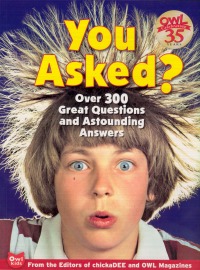| ________________
CM . . . . Volume XVII Number 40. . . .June 17, 2011. 
 |
You Asked? Over 300 Great Questions and Astounding Answers.
The Editors of chickaDEE and OWL Magazines.
Toronto, ON: Owl Kids, 2011.
160 pp., pbk. & hc., $16.95 (pbk.), $24.95 (hc.).
ISBN 978-1-926818-14-6 (pbk.), ISBN 978-1-926818-13-9 (hc.).
Subject Heading:
Science-Miscellanea-Juvenile literature.
Grades 3-6 / Ages 8-11.
Review by Gail Hamilton.
****/4
|
| |
|

excerpt:
Why do horses have “scabs” on their legs?
Those scab-like patches high on the insides of horses’ legs are known as “chestnuts,” and they’re what’s left of thumbs horses once had. The first horse ancestor was the size of a dog and had four toes per foot. Gradually, three of these toes fused into a hoof, which meant the horse could run faster. Once it had hooves, its thumbs- the fourth toes- were useless and slowly vanished, leaving only the chestnuts. They’re high on the legs because as horses evolved their foot bones grew longer. How much longer? Take a look at your hand. A horse’s front hoof is the same as the tip of your middle finger, its ankle compares to the knuckle at the base of that finger and its knee is the same as your wrist.
In celebration of OWL magazine’s 35th anniversary, this book is a re-issue of a compilation of the most interesting questions submitted to the magazine’s editors by young readers over the years. First published in 1996, the book has been updated to reflect the changing times and includes new, as well as original, photographs and illustrations. There are almost 350 questions and answers, grouped thematically, covering four major topics- the human body, science and technology, outer space, and plants and animals. Questions are answered by OWL and chickaDEE’s editors. Though the responses are factual and backed up by sound research, they are presented in a conversational writing style infused with touches of humour. In the rare cases that a definitive answer cannot be found, the editors readily admit that they do not know for sure, but they do offer some scientific theories. A few multiple choice and true or false quizzes are interspersed throughout the book, as are fun facts, a few examples of which are that the loudest hiccup ever heard was 1.6 km away and that, in a person’s lifetime, he or she will eat the equivalent weight of six elephants. A table of contents and an index are provided.
The questions within each chapter are grouped according to topic, with a double-page spread devoted to each category. For example, in the first chapter on the human body, questions about dreaming are grouped together, questions about the senses are grouped together, and so on, thus giving the chapter some semblance of order. Other topics in the section about the human body include bones, muscles, hair (and the lack of it), and intriguing topics such as why a person gets a “stitch” in the side after running, what causes an ice cream headache or what causes an itch.
Science and technology questions are many and varied. Lasers, quicksand, weather and fireworks are just a few of the topics covered. Curious readers will find out, among other things, why boats have round windows instead of square ones, why most cereals make a crackling noise when milk is added to them, and why bananas turn black in the refrigerator.
“Out of this world,” the chapter about outer space, features questions and answers about planets, the atmosphere, rainbows, black holes, northern lights, twinkling stars and the Hubble telescope. Interestingly, it was an 11-year-old girl who suggested the name Pluto when this planet was discovered in 1930. Though Pluto is now considered a dwarf planet, its name remains unchanged.
The final chapter is devoted to animals (both domestic and wild) and plants. In this section, readers will find out why a kitten doesn’t feel pain when its mother picks it up by the scruff of the neck, whether or not fish can sing, and what makes jumping beans jump. Some interesting facts about cashews are that they are not nuts, but seeds that grow on a tropical evergreen tree and that they are related to mangoes and poison ivy. Raw cashews are poisonous, but roasting destroys the poison.
Fun, fascinating and educational, You Asked? is sure to capture the imagination and interest of a new generation of readers.
Highly Recommended.
Gail Hamilton is Library Learning Resources Consultant at the Instructional Resources Unit, Manitoba Department of Education, in Winnipeg, MB.

To comment on this title or this review, send mail to
cm@umanitoba.ca.
Copyright © the Manitoba Library Association. Reproduction for personal use is permitted only if this copyright notice is maintained. Any other reproduction is prohibited without permission.
NEXT REVIEW |
TABLE OF CONTENTS FOR THIS ISSUE- June 17, 2011.
AUTHORS |
TITLES |
MEDIA REVIEWS |
PROFILES |
BACK ISSUES |
SEARCH |
CMARCHIVE |
HOME |
